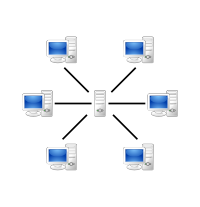Mesh networks are a new type of connectivity paradigm. Generally, when talking about wireless internet connectivity, individual are either "passive consumers" or "commercial providers". For example, when you are sitting at a coffee-shop, browsing the internet on a Wi-Fi wireless hotspot, you can only exchange information with your friend across the table by going first to the Wi-Fi hotspot's router and then to your friend. In other words, the Wi-Fi hotspot is the "provider" and you are just the "consumer" or client attached to that hotspot.
However, mesh networks turn this command-and-control schema on its head, by turning every individual connected to the network into a "provider" of internet connectivity. This makes mesh internet incredibly resistant to repressive regimes (please see previous post for more info and pictures of mesh networks.) To take the coffee-shop example up again, you could now send information directly to your friend sitting across the table, without going through any intermediate Wi-Fi hotspot routers, since you yourself are an internet provider in a mesh network. By directly connecting to your friends, and agreeing to pass along their messages in exchange for them passing along yours, a grassroots internet network of potentially very high speeds (<500 Mbps) is created.
The technology behind mesh networks is transformative for both the internet in general, and the Global Citizens Movement in particular. Already there are dozens of diverse users of mesh networks, from citizens to large businesses and governments. The U.S. military uses mesh technology for battlefield communication between military vehicles, for example. The One Laptop Per Child project (OLPC) from MIT and the U.N. incorporates mesh technology into laptops for students in the developing world. Mesh networks are also being used in Haiti to help in the disaster relief efforts and in India to provide broadband internet to rural villages.
You could use one of many wireless technologies to make a wireless mesh- Cellular, Wi-max, Wi-fi, etc., along with any of more than 70 routing protocols.
But making a Wi-Fi (802.11x) mesh network has several advantages-
- Wi-fi licenses are not required to create large scale Wi-fi networks in many countries, including India since the deregulation of this spectrum in 2005.
- Wi-fi router hardware is ubiquitous and relatively cheap.
- There have already been many practical, large-scale wireless Wi-Fi mesh networks established in places all over the planet, and there is shared expertise and experience as a result of this fact.
- Many free and open source software packages are already available for setting up and running a Wi-fi network.
Wi-Fi also shares the general advantages of wireless over wired communication, like-
- No cost for laying wires and cables.
- Easy to deploy in short amount of time
- Relatively cheap hardware relative to commercial mobile equipment
- Simple to shift coverage or expand your wireless range
Wi-Fi mesh networks are inherently decentralized, and that makes them stay functional even if power cuts or technical problems prevent some nodes from working properly. This is a major concern, especially in a developing country with poor electricity infrastructure. A mesh can simply "route around" these problem nodes, and the messages still get out.
This decentralization also makes mesh networks difficult to censor or shut down. See a forthcoming post about making Wi-Fi mesh networks even more resilient against repressive governments through the use of the "Cognitive" mesh.
Resources:
-How to set-up a Wi-Fi network in the developing world- "Wireless Networking in the Developing World"
-Open-source wireless mesh routing- OLSR








1 comment:
Post a Comment